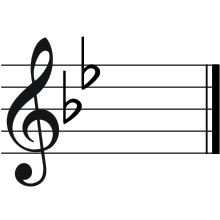B-flat major
In music theory, B-flat major is a major scale based on B♭, with pitches B♭, C, D, E♭, F, G, and A. Its key signature has two flats. Its relative minor is G minor and its parallel minor is B-flat minor.
 | |
| Relative key | G minor |
|---|---|
| Parallel key | B-flat minor |
| Dominant key | F major |
| Subdominant | E-flat major |
| Component pitches | |
| B♭, C, D, E♭, F, G, A | |
The B-flat major scale is:
Many transposing instruments are pitched in B-flat major, including the clarinet, trumpet, tenor saxophone, and soprano saxophone. As a result, B-flat major is one of the most popular keys for concert band compositions.
In most Central and Northern European languages (German, Hungarian, Nordic, Baltic, Western and Southern Slavic languages, except Bulgarian), the pitch B is usually called "H" while B♭ is called "B".
History
Joseph Haydn's Symphony No. 98 is credited as the first symphony he (or anyone else) wrote in that key in which he included trumpet and timpani parts. Actually, his brother Michael Haydn had written one such symphony earlier, No. 36, though Joseph Haydn still gets credit for writing the timpani part at actual pitch with an F major key signature (instead of transposing with a C major key signature), a procedure that made sense since he limited that instrument to the tonic and dominant pitches.[1] Many editions of the work, however, use no key signature and specify the instrument as "Timpani in B♭–F".
Five of Mozart's piano concertos are in B-flat major.
Notable classical compositions
- François Couperin
- Johann Sebastian Bach
- Brandenburg Concerto No. 6
- Luigi Boccherini
- Cello Concerto No. 9, G. 482
- Joseph Haydn
- Wolfgang Amadeus Mozart
- The aria Voi che sapete from the opera The Marriage of Figaro
- Symphony No. 5
- Symphony No. 24
- Symphony No. 33
- Piano Concerto No. 6
- Piano Concerto No. 15
- Piano Concerto No. 18
- Piano Concerto No. 27
- String Quintet No. 1
- String Quartet No. 17 (Hunt)
- Violin Sonata No. 32
- Piano Sonata No. 3
- Piano Sonata No. 13 (Linz)
- Piano Sonata No. 17
- Ludwig van Beethoven
- Piano Concerto No. 2
- Symphony No. 4
- String Quartet No. 6
- String Quartet No. 13
- Große Fuge
- Piano Sonata No. 11
- Piano Sonata No. 29 (Hammerklavier)
- Piano Trio No. 7 (Archduke)
- Franz Schubert
- Felix Mendelssohn
- Frédéric Chopin
- Robert Schumann
- Symphony No. 1 "Frühling", Op. 38
- The second, fourth and sixth movement of Kreisleriana, Op. 16
- Humoreske for piano, Op. 20
- Faschingsschwank aus Wien for piano, Op. 26
- Anton Bruckner
- Johannes Brahms
- Bohuslav Martinů
- Sergei Prokofiev
- Dmitri Shostakovich
- Ottorino Respighi
- Moritz Moszkowski
- 8 Morceaux caractéristiques Op. 36, no. 6 "Etincelles"
- Stephen Heller
- Étude Op. 46, No. 21
- Felix Blumenfeld
- Prelude Op. 17, No. 21
- Ferrucio Busoni
- Prelude Op. 37, No. 21
- Anton Arensky
- 24 Morceaux caractéristiques Op. 36, no. 21 "Marche"
References
- H. C. Robbins Landon, Haydn Symphonies, London: British Broadcasting Corporation (1966): 57